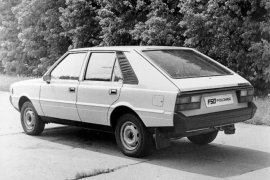FSO Polonez Models/Series Timeline, Specifications & Photos
First production year: 1978
Engines: Gasoline
Since the state-owned Polish company had a long history with the Italian automaker Fiat, they struck a deal to create a new vehicle that could fit into the East-European block market.
FSO had a long-term relationship with Fiat that started back in 1932, and after WWII, the cooperation continued. After producing the Fiat 125 under license for several years, the Polish government wanted something newer. Fiat, on the other hand, already had the ESV project penned in 1970 by the famous Italian stylist Giorgetto Giugiaro, although it was meant to fit on another platform. A Polish designer, together with a young designer named Walter da Silva, adapted the car to fit onto the platform of the 125 model that had already been produced in Poland. Then, in 1978, the FSO Polonez appeared on the market. Later on, it was exported to other countries, including in Western Europe.
The car’s front fascia featured twin-round headlights that were still trendy in Europe, similar to those installed in the Fiat 125. Even though it was an old design, it still looked up to date. A flat plastic grille with horizontal black slats adorned the Polonez and supported the round badge of the FSO brand. Below it, the automaker placed the plastic bumper reinforced with rubber stripes and a lower apron underneath it.
From its profile, the long overhangs were the price paid by the automaker for using a platform carried over from the Fiat 125, which was introduced in 1967. FSO carried over the flush door handles from the same model and installed them on the 1978 Polonez. Thanks to the fastback shape of the bodywork, the car didn’t look outdated since that trend started to pick up speed in Europe, especially for mass-market vehicles. A particular detail for this early version of the car was the wide C-pillars that didn’t sport a third set of windows in them.
Inside, the automaker boasted in its selling brochures that the car featured a dashboard with a speedometer, a rev counter, gauges for the oil pressure and coolant temperature, and nine warning lights. The cloth upholstery was the only option for the car, but at least the steering had a tilt adjustment. In the back, there was enough room for the rear-seated passengers, although the transmission tunnel was tall and obstructed the legroom for a third, middle-seated one.
Under its skin, the 1978 Polonez had the same underpinnings as the 1967 Fiat 125. The automaker offered the car with a choice of two engines, a 1.3-liter and a 1.5-liter, featuring on-head valves. In the first years of production, the car came with a four-speed manual gearbox, but later, the 1.5-liter powerplant was paired with a five-speed transmission. Both versions sent their power to the rear wheels via a solid axle supported by leaf springs.
